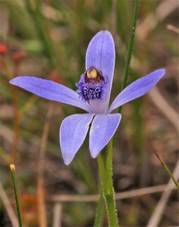The orchid world is a complex one, often posing far more questions than we have answers for.
Why do certain orchid species grow in some places, and yet just further along the track where the conditions seem identical, there is no sign of an orchid? We know that there is a close association between orchids and mycorrhizal fungus, which actually invades the orchid cells, usually upon germination of the seed. As there are almost no food reserves in the seed, the germinating embryo relies on the fungus to supply nutrients for continuing growth.
One little orchid that asks questions in our district is Blue Fingers Cyanicula caerulea, a deep blue orchid that grows on a wiry, hairy stem to just 15 cm tall.

Blue Fingers
Since I have become interested in orchids, I have seen this species in the district about eight times – seeing, each time, just one of these beautiful little orchids on the side of a track, standing, as it usually greets you, with its dorsal sepal stiffly erect, and its petals and lateral sepals spreading. I have seen it in the same place on the coastal walk at Anglesea a few times, once near Gilbert St at Aireys Inlet, once on Currawong Falls track, once near the dam at Moggs Creek, once on the roadside near Mawson Ave, and this August, in the Anglesea heathlands at the top of Harvey St. Yet, venture out into the Brisbane Ranges, and you may find hundreds of Blue Fingers forming loose colonies, often containing small clumps of plants. Who knows the answer?
Another small blue orchid, which is easier to understand, is the Bluebeard Orchid Pheladenia deformis. This species flowers well after bushfires, when spectacular clumps of flowers may catch your eye. However, it is often found in areas that have not been recently burnt, and is widespread, although not common, in the area. Bluebeard has congested calli on the labellum, forming the distinctive ‘beard’ of its name. This is very different from that of Blue Fingers, which is bright blue, with darker transverse stripes, and calli in two rows.

Blue Beard Orchid
So many orchids are in flower at the moment that it is certainly a delight to be out in the field. Leopard Orchids Diuris pardina have been flowering in profusion. Spider Orchids – Red-lipped Caladenia oenochila, Thick-lipped C. cardiochila, Plain-lip C. clavigera and Small Spider Orchids C. parva are all in flower. Wax-lip Orchids Glossodia major are appearing in all shades of mauve, deep purple, and the occasional white. The National Park at the corner of O’Donohue Rd and Harvey St, and the Fraser Ave Reserve, are both well worth a visit to view many of these species.
Pink Fairies Caladenia latifolia are flowering magnificently on the dunes at Pt Roadknight, off Melba Pde. Sun Orchids Thelymitra sp. are in bud, and we look forward to some colourful flowers, with these beautiful spring orchids. Wallflower or Donkey Orchids Diuris orientis, with their large, colourful flowers, are also in flower. The endemic Large Bearded Greenhood Pterostylis sp. aff plumosa (Anglesea), with its distinctive labellum with long golden hairs, is flowering in many places.
Photos and descriptions of all the orchids that grow in the Anglesea district are documented in Orchids of the Anglesea District available from Angair.
Margaret MacDonald